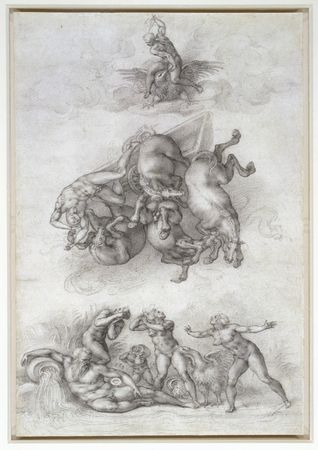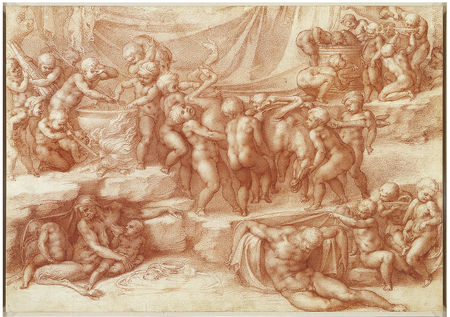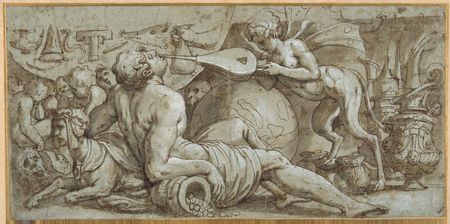"Michelangelo's Dream" @ The Courtauld Gallery
Michelangelo Buonarroti (1475-1564) Dream of Human Life, c. 1533 ©The Courtauld Gallery
‘Drawings the like of which have never been seen…’ Giorgio Vasari, 1568
Michelangelo’s masterpiece The Dream (Il Sogno) has been described as one of the finest of all Renaissance drawings and it is amongst The Courtauld Gallery’s greatest treasures. Executed in c. 1533 when Michelangelo Buonarroti (1475-1564) was at the height of his career, it exemplifies his unrivalled skill as a draughtsman and his extraordinary powers of invention. Michelangelo’s Dream examines this celebrated work in the context of an exceptional group of closely related drawings by Michelangelo, as well as original letters and poems by the artist and works by his contemporaries.
The Dream is one of Michelangelo’s ‘presentation drawings’, a magnificent and famous group of highly refined compositions which the artist gave to his closest friends. These beautiful and complex works transformed drawing into an independent art form and are amongst Michelangelo’s very finest creations in any medium. The Dream was probably made for a young Roman nobleman called Tommaso de’ Cavalieri, who was celebrated for his outstanding beauty, gracious manners and intellect. Michelangelo had first met him in Rome in the winter of 1532 and had instantly fallen in love. The Dream is likely to have been part of the superb group of drawings which Michelangelo gave to Cavalieri during the first years of their close friendship. This group forms the heart of the exhibition and includes The Punishment of Tityus (fig. 2), The Fall of Phaeton (fig. 3), A Bacchanal of Children (fig. 5) and The Rape of Ganymede. In his Life of Michelangelo (1568) the biographer and artist Giorgio Vasari praised these exceptional works as ‘drawings the like of which have never been seen’ – and they are still regarded as amongst the greatest single series of drawings ever made.
Michelangelo Buonarroti (1475-1564) The Punishment of Tityus, 1532. Black chalk, 19 x 33 cm. Royal Collection ©2008 Her Majesty Queen Elizabeth II
Michelangelo Buonarroti (1475-1564) The Fall of Phaeton, 1533. Black chalk, 41.1 x 23.4 cm. Royal Collection ©2008 Her Majesty Queen Elizabeth II
Michelangelo Buonarroti (1475-1564) A Bacchanal of Children, c. 1533. Red chalk, 27.1 x 38.5 cm. Royal Collection ©2008 Her Majesty Queen Elizabeth II
Michelangelo’s drawings for Cavalieri have not been seen together for over twenty years and this is the first time that The Dream will be shown as part of this group. Exceptionally also, The Fall of Phaeton will be reunited with two earlier versions of this composition (fig. 4). Both carry inscriptions in Michelangelo’s hand, one requesting Cavalieri’s approval of the preliminary design.
Michelangelo Buonarroti (1475-1564) The Fall of Phaeton (inscribed by Michelangelo), 1533. Black chalk, 31.1 x 21.6 cm. The British Museum, London
The exhibition starts with the earliest surviving letter from Michelangelo to Cavalieri, dated 1 January 1533, in which the artist expresses his delight that Cavalieri had agreed to accept the gift of some drawings. Cavalieri is thought to have been no older than 17 at the time and, according to Vasari, Michelangelo’s gifts were primarily intended to teach him how to draw. The mythological stories such as Phaeton falling to earth with the chariot of the sun, the abduction of Ganymede – the most beautiful of mortals – and the punishment of the lustful giant Tityus may also have been intended to offer moral guidance. The drawings certainly also served as expressions of Michelangelo’s love for Cavalieri.
Michelangelo’s ardour is eloquently described in the poems (fig. 7) which the artist composed for Cavalieri, mainly in the early phase of their friendship. Five handwritten sonnets are included in the exhibition; most of these are here shown for the first time. Whilst adhering to the conventions of love poetry, these sonnets record with extraordinary intensity Michelangelo’s adoration of the young man whose sublime beauty he regarded as a reflection of God’s eternal beauty on earth. The poetic imagery of dreaming, transcendence and the struggle between the carnal and the spiritual realms offers insight into the meaning and function of the presentation drawings, and The Dream in particular.
Michelangelo Buonarroti (1475-1564) Sonnet for Tommaso de’ Cavalieri, ‘I do not know if it is the very longed-for light’ (Non so se s'è la desiata luce), composed c. 1534; edited for planned publication in 1546. Pen and ink, 28.5 x 20 cm. Casa Buonarroti, Florence
The presentation drawings created an immediate sensation at the court of Pope Clement VII in Rome. In an early letter to Michelangelo, included in the exhibition, Cavalieri wrote that they had been admired by ‘the Pope, Cardinal de Medici and everyone’, adding apologetically that the Cardinal had already taken away Ganymede to have a replica made in crystal. The Dream too became famous amongst Renaissance collectors and artists soon after its completion and was copied numerous times. However, its precise meaning has remained elusive. Rather than illustrate a text, the drawing engages with contemporary (neo-Platonic) ideas about the ascent of the soul to the divine, aided by beauty. The composition shows an idealised nude youth reclining against a globe. Masks fill the open plinth on which he is seated. The swirling dreamlike mass of figures surrounding the young man have traditionally been linked with the vices. They enact scenes of gluttony, lust, avarice, wrath, sloth and envy, with a large phallus adding to the carnal imagery. A winged spirit – possibly a personification of beauty and chaste love – approaches the youth with a trumpet, awakening him from the illusions and deceits of the earthly realm to a new spiritual life. A single precise meaning for this complex allegory seems unlikely as the presentation drawings were clearly intended for careful scrutiny and prolonged learned discussion and enjoyment.
A further highlight of the exhibition is a superb group of drawings by Michelangelo of Christ’s resurrection, which concentrate on the heroic nude figure of the reborn Christ leaping free of the tomb and the bondage of life on earth. These drawings offer close thematic and formal comparisons with The Dream. This group includes the glorious Risen Christ (fig. 6) – widely celebrated as one of the most magnificent and potent figures in Michelangelo’s art.
Michelangelo Buonarotti (1475-1564) The Risen Christ, c. 1532. Black chalk, 37 x 22 cm. Royal Collection ©2008 Her Majesty Queen Elizabeth II
The exhibition further investigates the meaning of The Dream in the context of closely related works by Michelangelo’s contemporaries which address themes of rebirth, dreaming and the nature of Man. This section of the exhibition includes Albrecht Dürer’s enigmatic drawing of a bound youth (fig. 8) and Giorgio Vasari’s free interpretation of The Dream (fig. 9). The final section of the exhibition focuses on copies of The Dream and illustrates how Michelangelo’s contemporaries and later admirers responded to the puzzling subject matter and the extraordinary technical virtuosity of Michelangelo’s great work.
Albrecht Dürer (1471-1528) Six nude figures, 1515. Pen and brown ink, 27 x 21.1 cm. Das Städel Museum, Frankfurt am Main
Giorgio Vasari (1511-1574) Allegory of a Dream, c. 1541-45. Pen and brown ink, heightened with white, on blue paper, 19.2 x 39.4 cm. The Devonshire Collection, Chatsworth
The friendship between Cavalieri and Michelangelo endured for thirty years. Cavalieri was present at the artist’s death in 1564 and subsequently helped to realise some of his architectural schemes. He so valued the drawings given to him by Michelangelo that Vasari was to say: ‘…in truth he rightly treasures them as relics’.
The exhibition has been developed with the support of major international collections including The Royal Collection, Windsor; The British Museum, London; Casa Buonarotti, Florence; Biblioteca Apostolica Vaticana, Rome; The Devonshire Collection, Chatsworth; the Wallraf-Richartz Museum, Cologne; Christ Church Picture Gallery, Oxford; Staatliche Graphische Sammlung, Munich; Das Städel Museum, Frankfurt am Main; Bibliothèque nationale de France, Paris; Harvard University Art Museums, Cambridge MA, and the Gallerie dell’Accademia, Venice.
Bringing together a focused selection of some of the artist’s very finest drawings, Michelangelo’s Dream promises to be one of the most enthralling exhibitions of 2010.
18 February-16 May 2010. The Courtauld Gallery, Somerset House, Strand, London, WC2R 1LA, UNITED KINGDOM http://www.courtauld.ac.uk/

/https%3A%2F%2Fprofilepics.canalblog.com%2Fprofilepics%2F1%2F0%2F100183.jpg)











/http%3A%2F%2Fstorage.canalblog.com%2F15%2F66%2F577050%2F55574283_o.jpg)
/http%3A%2F%2Fstorage.canalblog.com%2F51%2F95%2F119589%2F52772885_p.jpg)
/http%3A%2F%2Fstorage.canalblog.com%2F14%2F42%2F577050%2F51183238_o.jpg)
/http%3A%2F%2Fstorage.canalblog.com%2F60%2F09%2F577050%2F49884144_o.jpg)